The Ultimate Guide to Banishing Ants from Your Kitchen Forever (Guide)
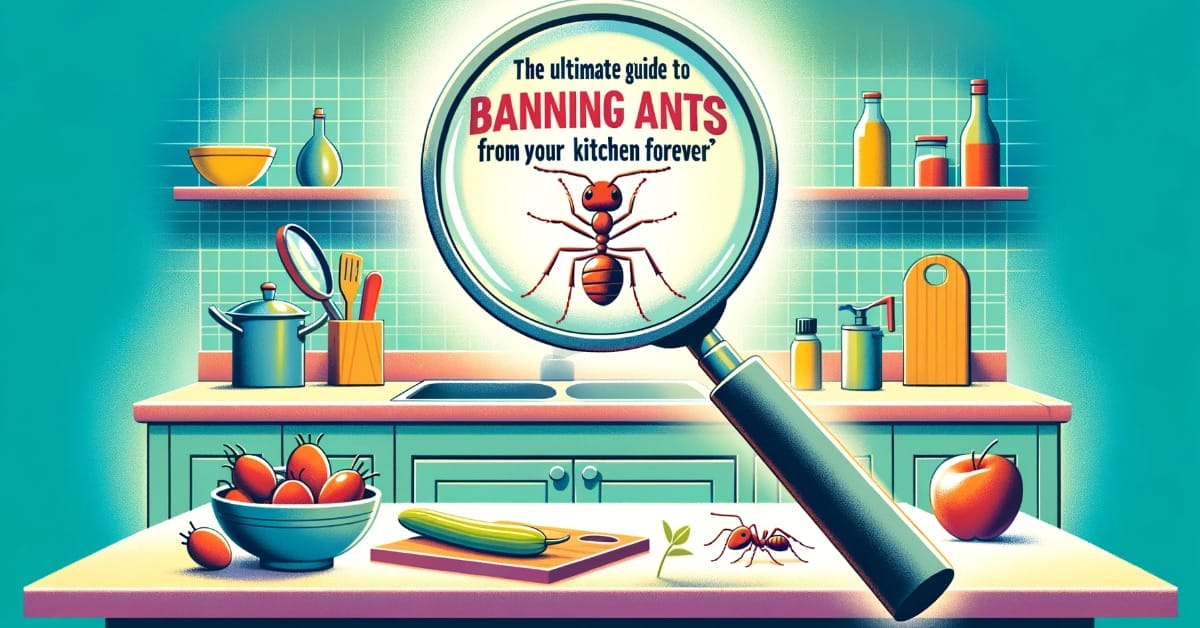
I know how frustrating it can be to see ants crawling around your kitchen sink and countertops. Don’t worry; I’ve got some proven ant removal methods to help you regain control of your cooking space!
Here’s a Sneak Peek at Your Ant-Busting Guide:
🔍 Step 1: Hunt down their kitchen entry points.
🔗 Step 2: Track ’em to their nest.
🌶️ Step 3: Break out the deterrents.
⚠️ Step 4: Chemical warfare, with care.
🪤 Step 5: Trap ’em with a store trap.
🌪️ Step 6: A sprinkle a day keeps ants away.
🚫 Step 7: Fortify your fortress.
We’re diving deep into a game plan to kick those ants out of your kitchen for good. From solid action steps to essential maintenance advice, safety guidelines, and even a glance at some alternative tactics, we’ve got all the bases covered. Ready to reclaim your space?
Why Are Ants Suddenly in My Kitchen?
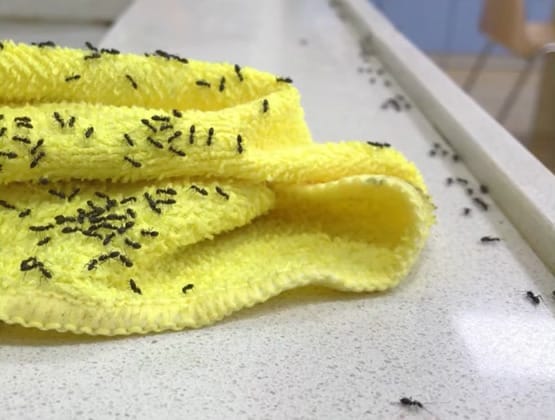
Ants might suddenly pop up in your kitchen if they discover a food source. Communicating with their colony via pheromone trails they can lead many ants to your kitchen in a short amount of time.
These little pests prefer sweet foods such as honey, sugar, fruit juice, and syrup, encouraging them to establish their presence in your kitchen. Ants also need water to survive, and if they find a steady water source in your home, they’ll be more likely to stick around.
You’ll typically see fewer ants during winter since they usually hibernate during the colder months. Hot and dry weather, heavy rains, or damp indoor environments can draw ants back into your kitchen.
Steps to Get Rid of Ants
No one likes uninvited guests, especially ants marching into our kitchens. Whether they’re after your leftover pizza or that sugary spill on the counter, it’s time to roll up those sleeves and tackle this invasion head-on.
Let’s dive into the step-by-step to show these tiny trespassers the door!
Step 1: Spot the Entry Point

- Spend some time observing where the ants are coming from—they could enter through floor cracks, gaps in window sills, or holes in cabinets.
- You’ll need to address this entry point later in the ant removal process, but hold off on sealing it.
Step 2: Track Down Their Home Base
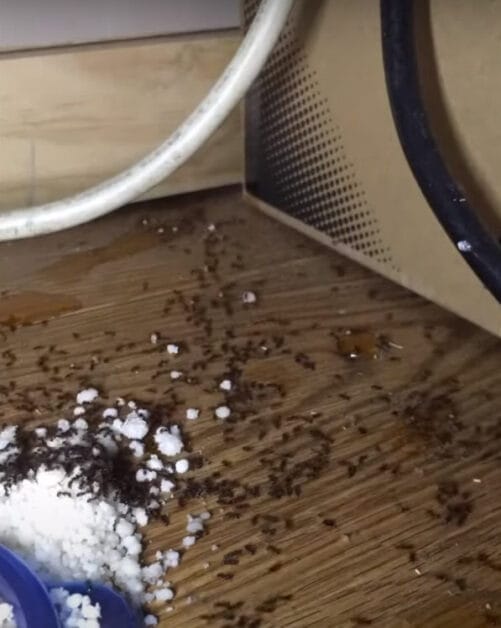
- Follow the ants as they leave the kitchen with their spoils to find the nest, either outside (on the ground or in a tree) or indoors (in moisture-damaged walls or cabinets).
- The nest often looks like a mound of debris or decaying leaves.
Step 3: Eliminate the Nest using Natural Methods
Here are a few natural ways to tackle the ant issue:

- Pepper: Ants dislike the smell of cayenne and black pepper, so sprinkle some near the infestation to deter them from entering your home.

- Vinegar: A 1:1 mixture of vinegar and water in a spray bottle helps deter ants and disrupts their pheromone trails. Spray the ants, their trail, and around your kitchen.

- Food-grade diatomaceous earth: Applying a thin layer of this powder in various spots can slice ants’ exoskeleton and cause them to dry out and die.
Step 4: Destroy the Nest using Insecticides
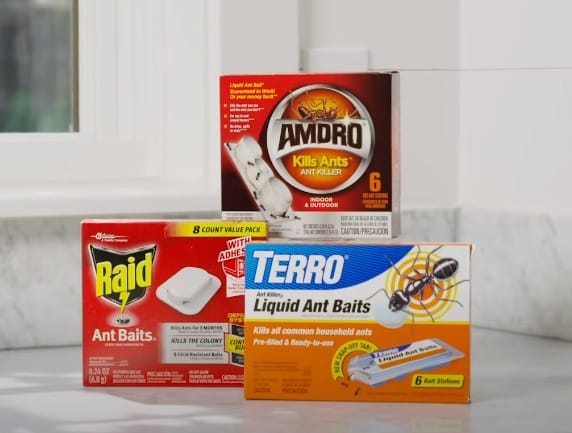
- If natural methods don’t work, consider using a non-repellent insecticide. However, be cautious about using insecticides as they harm children, pets, and adults.
- Always read the label, follow instructions, and weigh the benefits versus risks before using chemical insecticides.
Step 5: Set Up Commercial Traps or Natural Ant Killers to Eliminate the Colony
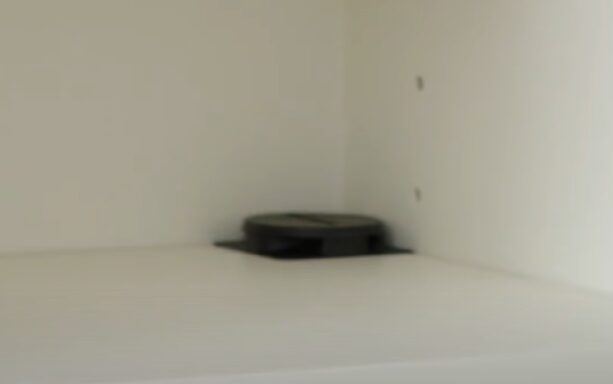
- Using bait traps can help lure ants away from your kitchen and eradicate the colony.
Step 6: Remove the Remaining Ants with Diatomaceous Earth
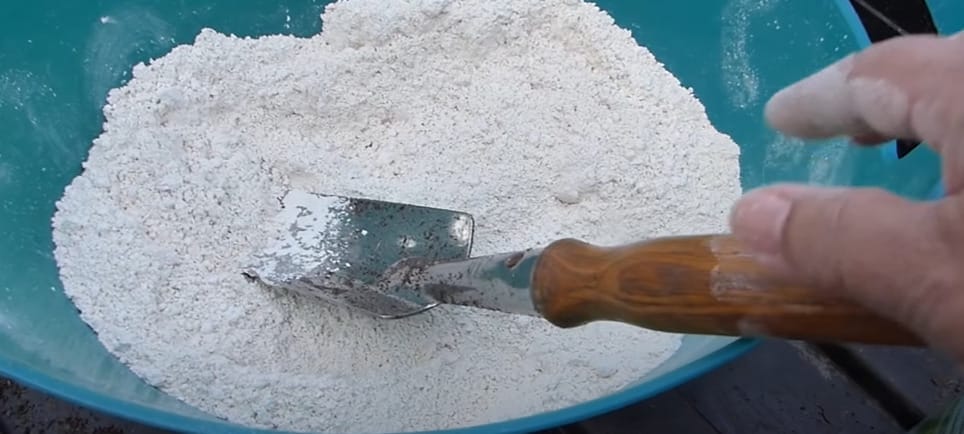
- A fresh daily layer of food-grade diatomaceous earth can help clear out any remaining ants—just be careful not to breathe it in or get it on your skin.
Step 7: Prevent Future Infestations by Sealing Entry Points
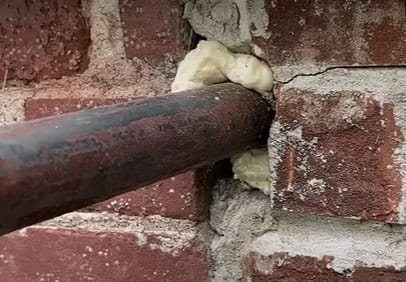
- Caulk gaps, repair cracks, and seal holes to keep ants from entering your home again.
Ant-Proofing: Keep Your Kitchen Clear
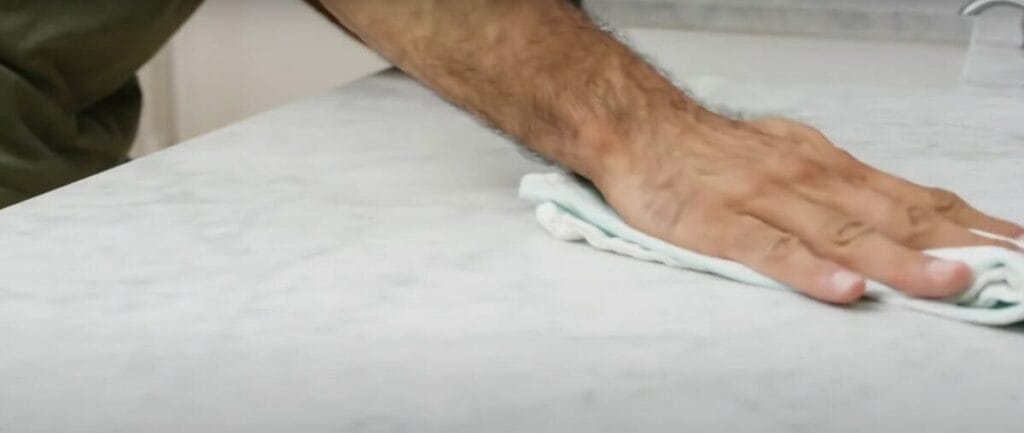
Alright, team! So you’ve shown those ants the door, but how do we ensure they don’t waltz back in? Let’s lay down some ground rules to keep your space ant-free.
- Keep It Clean: Regularly scrub those kitchen countertops, floors, and cabinets well. Use the right cleaners for each surface, and you’re golden.
- Seal the Deal on Food: No open invitations! Store food in sealed containers, whether your sandwich or Fido’s kibble. And remember, spills are an ant’s best friend—quick clean-ups are key.
- No Watering Holes: Ants are always looking for a drink. Wipe up those spills promptly, and let’s not leave dishes soaking too long. A dry sink is a happy sink!
- Trash Talk: Keep those garbage can lids snug. Empty them every couple of days to keep things fresh.
- DIY Repellents: Make your space a no-go zone for ants. Mixing peppermint oil and water, apple cider vinegar concoctions, or even a dash of cinnamon can do the trick. Find your favorite and give it a try!
- Check for Leaks: A little water can lead to big problems. Regularly inspect your kitchen for any sneaky leaks and get them sorted. No moisture means no indoor ant nests.
- Nature’s Bridge: Got tree branches cozying up to your home? Trim them back. They could be a VIP entrance for ants, especially if there’s a nest in the tree.
Alternative Methods: The Road Less Traveled
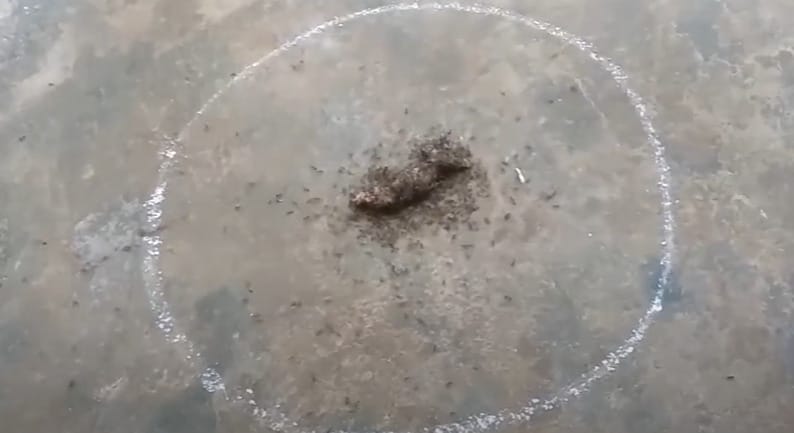
Alright, folks! While we’ve gone through the tried and true methods to send those ants packing, there are a few other techniques you might have heard whispers about in the grapevine. Let’s shine a light on them:
- Lemon Juice: Some say ants aren’t fans of citrus. The scent might deter them, but lemon juice isn’t the most effective long-term solution. It might make your kitchen smell zesty, but those ants will probably find another way.
- Chalk Lines: Drawing lines with chalk around entry points is a popular old wives’ tale. The idea is that ants don’t like calcium carbonate in chalk. While it might disrupt their path momentarily, they’ll find a detour.
- Coffee Grounds: Have you heard of this one? Sprinkling used coffee grounds around the house can act as a deterrent. But here’s the catch: it’s a temporary fix. Ants might avoid the grounds but won’t pack their bags and leave.
- Cucumber Peels: Another interesting method! Some believe ants dislike the taste. But let’s be real: leaving vegetable peels around can attract other pests. We’re trying to solve a problem, not create a new one!
- Baking Soda and Sugar: This combo acts as a homemade bait. Ants are attracted to the sugar but are harmed by the baking soda. While it might work somewhat, it’s not as targeted or effective as commercial ant baits.
While these methods sound intriguing (and might even work for a short stint), they aren’t the heavy hitters we need for a lasting ant-free kitchen, that’s why we stuck to the main steps, ensuring you get results that last!
Safety Precautions: Safe and Sound in Ant-Battling
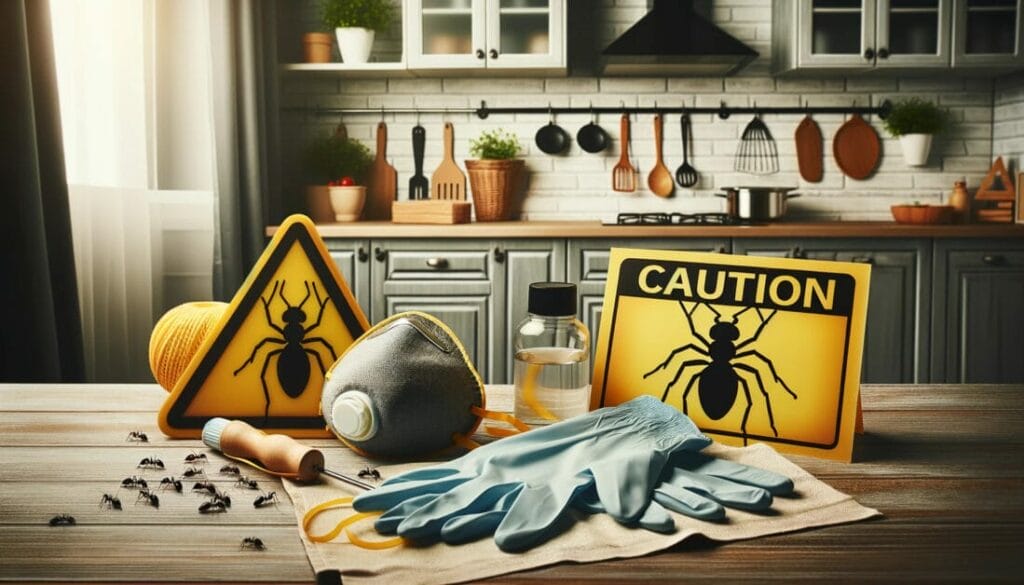
Hey there, home heroes! Before diving headfirst into the ant-battling arena, we must prioritize safety. After all, a secure home is a happy home. Let’s break down some vital safety measures:
- Read the Fine Print: Always read the label, whether insecticides or natural solutions. It’s not just about how to use them but also about storing them correctly. Even the most natural deterrent can be harmful if ingested.
- Child and Pet Alert: Kids and our furry friends are naturally curious, so let’s keep them safe—store chemical and natural ant deterrents in high or locked cabinets. Remember, just because something is natural doesn’t mean it’s safe for consumption.
- Gear Up: Wear gloves When applying insecticides or natural deterrents. If you’re sprinkling powders, consider wearing a mask to avoid inhalation. Safety first!
- Ventilation is Key: Using sprays? Ensure your kitchen is well-ventilated. Open windows and doors, allowing any fumes to disperse. It’s not just about the smell; it’s about keeping the air quality in check.
- Avoid Food Areas: If you’re treating areas near where you store or prepare food, be extra cautious. Cover food, dishes, and utensils, and always wash surfaces thoroughly after treatment.
- Emergency Contacts: Accidents happen. Keep the number of your local poison control center handy. If someone ingests any natural product, seek medical advice immediately.
Being proactive in ant removal is great, but always keeping safety at the forefront is essential. Here’s to a safe, effective, and ant-free kitchen journey!
Frequently Asked Questions
- How Long Does It Take for Ant Baits to Work?
- Patience is key! Ant baits can take a few days to weeks to show results. The idea is for the ants to carry the bait back to their colony, affecting the entire group.
- How Can I Tell If I Have a Serious Infestation?
- If you consistently see large numbers of ants or spot them in multiple areas of your home, it might be more than just a stray group looking for food. This could signal a larger nest or colony nearby.
- Do I Need to Empty My Kitchen Before Using Insecticides?
- Not necessarily, but you’ll want to be careful. Cover and store away food, dishes, and utensils. Make sure to ventilate the area well and clean surfaces thoroughly after treatment.
- When Should I Call a Professional?
- If you’ve tried multiple methods and still see no improvement after a few weeks, it might be time to bring in the big guns. Professionals can identify the type of ant and treat it accordingly, ensuring a more targeted approach.
- Do Ants Have a Preference for Organic Foods?
- Not really. While we love our organic goodies, ants aren’t too picky. They’re more attracted to the type of food – be it sweet, greasy, or meaty – rather than whether it’s organic or not.
- Why Do I Only See Ants at Night?
- Some ant species are more nocturnal in nature. They might venture out more during the cooler and quieter nighttime hours, especially if daytime conditions are too hot or dry.
- Can Ants Cause Damage to My Home?
- While most ants in the kitchen are nuisance pests, some species, like carpenter ants, can damage wood in your home. If you suspect you have these, addressing the issue quickly is essential.
References
Organizations:
- National Pest Management Association. https://www.pestworld.org/
- Entomological Society of America. https://www.entsoc.org/
Books:
- “The Ants” by Bert Hölldobler and Edward O. Wilson. https://www.goodreads.com/en/book/show/115013
- “Natural Enemies Handbook: The Illustrated Guide to Biological Pest Control” by Mary Louise Flint. https://books.google.com/books/about/Natural_Enemies_Handbook.html?id=FBJvpMqcV9UC
Website Resources:
- AntWeb. https://www.antweb.org/
- PestWorld for Kids. http://www.pestworldforkids.org/
Video References:
Tayloe’s Lawn Care Services
The Home Depot
Roman Maronie
Job Janissen
Fight Bugs
World’s Greatest Dad Reviews
Cultivating Organic by Jo & Mig
Everyday Home Repairs
Andrew SME
